Microplate Reader in Biomedical Science: Disease Detection Methods
VerifiedAdded on 2022/08/23
|6
|1384
|19
Presentation
AI Summary
This presentation provides a comprehensive overview of the microplate reader, a crucial instrument in biomedical science. It begins with a basic configuration and working principle, highlighting how it measures interactions in microplates. The presentation then delves into recent advancements, including various types of microplate readers such as multimode, luminescence, absorbance, and fluorescence readers, with an emphasis on ELISA (enzyme-linked immunosorbent assay) plate readers. The working mechanism of ELISA, including antigen-antibody interactions in sandwich ELISA, is explained. Finally, the presentation explores the applications of microplate readers in detecting diseases like Dengue, mumps, measles, herpes viruses, and oxidative stress-related conditions, along with examples of studies utilizing microplate readers for disease detection and the development of point-of-care diagnostic tools. The presentation is supported by references to relevant research articles. This presentation is available on Desklib, a platform providing AI-based study tools for students.
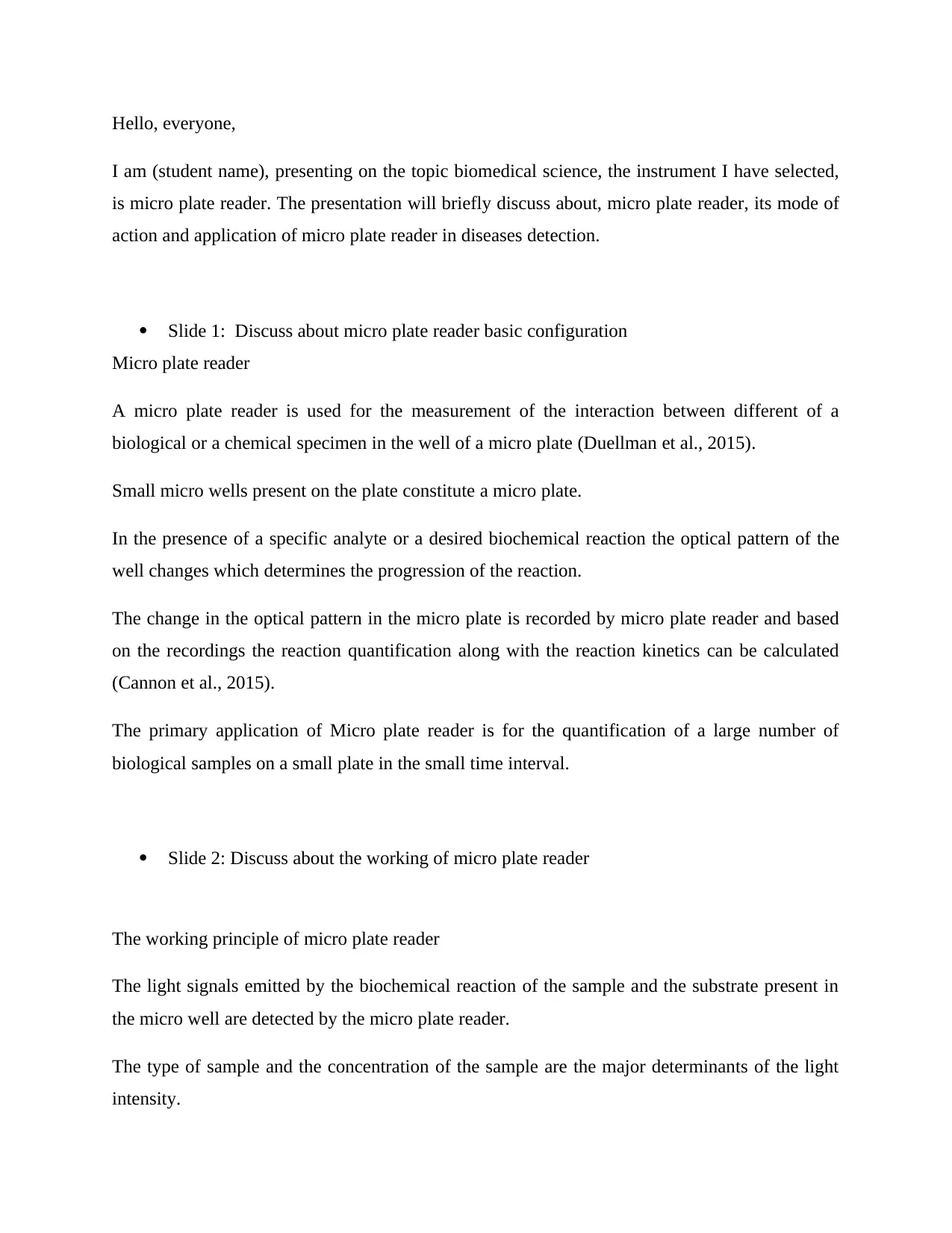
Hello, everyone,
I am (student name), presenting on the topic biomedical science, the instrument I have selected,
is micro plate reader. The presentation will briefly discuss about, micro plate reader, its mode of
action and application of micro plate reader in diseases detection.
Slide 1: Discuss about micro plate reader basic configuration
Micro plate reader
A micro plate reader is used for the measurement of the interaction between different of a
biological or a chemical specimen in the well of a micro plate (Duellman et al., 2015).
Small micro wells present on the plate constitute a micro plate.
In the presence of a specific analyte or a desired biochemical reaction the optical pattern of the
well changes which determines the progression of the reaction.
The change in the optical pattern in the micro plate is recorded by micro plate reader and based
on the recordings the reaction quantification along with the reaction kinetics can be calculated
(Cannon et al., 2015).
The primary application of Micro plate reader is for the quantification of a large number of
biological samples on a small plate in the small time interval.
Slide 2: Discuss about the working of micro plate reader
The working principle of micro plate reader
The light signals emitted by the biochemical reaction of the sample and the substrate present in
the micro well are detected by the micro plate reader.
The type of sample and the concentration of the sample are the major determinants of the light
intensity.
I am (student name), presenting on the topic biomedical science, the instrument I have selected,
is micro plate reader. The presentation will briefly discuss about, micro plate reader, its mode of
action and application of micro plate reader in diseases detection.
Slide 1: Discuss about micro plate reader basic configuration
Micro plate reader
A micro plate reader is used for the measurement of the interaction between different of a
biological or a chemical specimen in the well of a micro plate (Duellman et al., 2015).
Small micro wells present on the plate constitute a micro plate.
In the presence of a specific analyte or a desired biochemical reaction the optical pattern of the
well changes which determines the progression of the reaction.
The change in the optical pattern in the micro plate is recorded by micro plate reader and based
on the recordings the reaction quantification along with the reaction kinetics can be calculated
(Cannon et al., 2015).
The primary application of Micro plate reader is for the quantification of a large number of
biological samples on a small plate in the small time interval.
Slide 2: Discuss about the working of micro plate reader
The working principle of micro plate reader
The light signals emitted by the biochemical reaction of the sample and the substrate present in
the micro well are detected by the micro plate reader.
The type of sample and the concentration of the sample are the major determinants of the light
intensity.
Paraphrase This Document
Need a fresh take? Get an instant paraphrase of this document with our AI Paraphraser
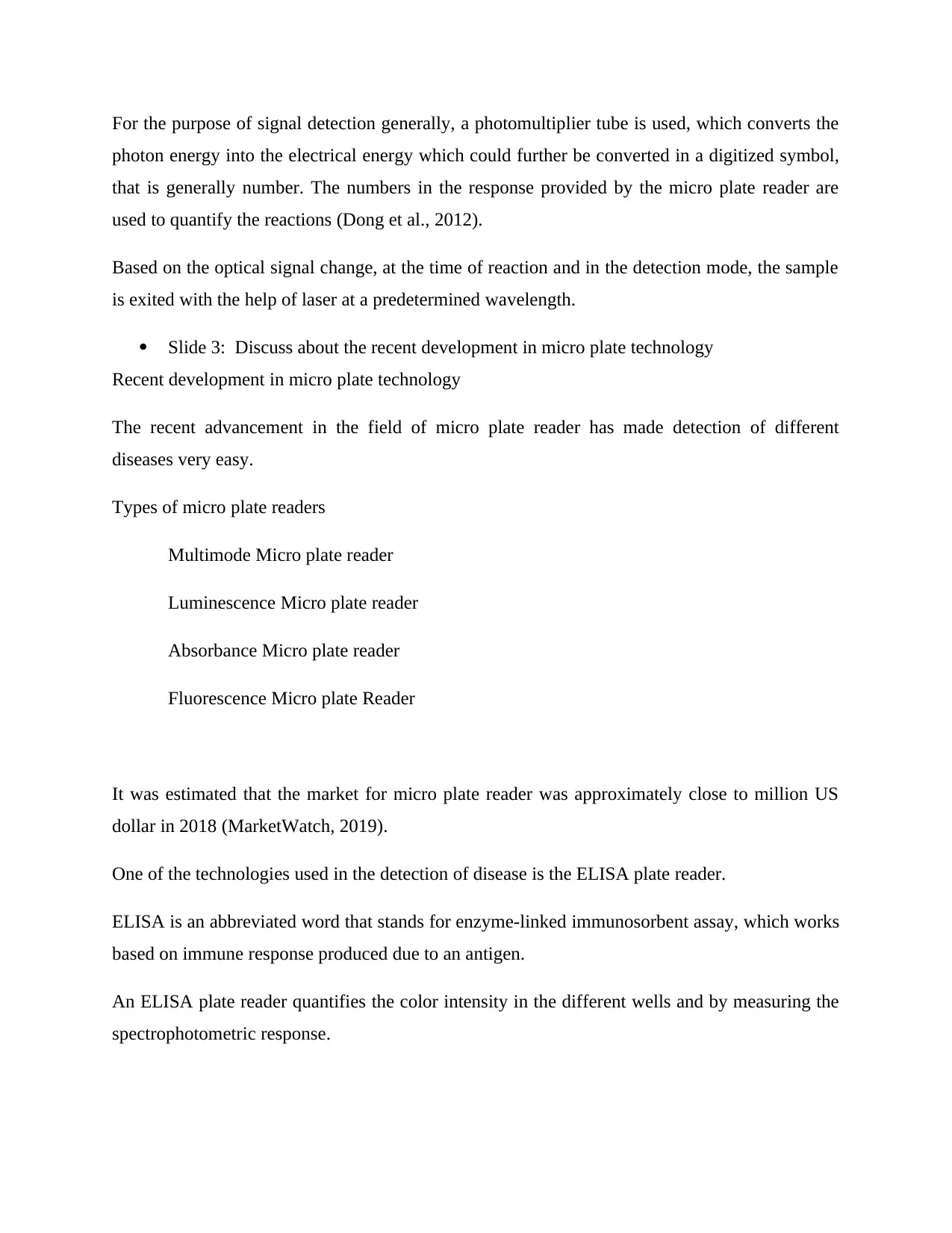
For the purpose of signal detection generally, a photomultiplier tube is used, which converts the
photon energy into the electrical energy which could further be converted in a digitized symbol,
that is generally number. The numbers in the response provided by the micro plate reader are
used to quantify the reactions (Dong et al., 2012).
Based on the optical signal change, at the time of reaction and in the detection mode, the sample
is exited with the help of laser at a predetermined wavelength.
Slide 3: Discuss about the recent development in micro plate technology
Recent development in micro plate technology
The recent advancement in the field of micro plate reader has made detection of different
diseases very easy.
Types of micro plate readers
Multimode Micro plate reader
Luminescence Micro plate reader
Absorbance Micro plate reader
Fluorescence Micro plate Reader
It was estimated that the market for micro plate reader was approximately close to million US
dollar in 2018 (MarketWatch, 2019).
One of the technologies used in the detection of disease is the ELISA plate reader.
ELISA is an abbreviated word that stands for enzyme-linked immunosorbent assay, which works
based on immune response produced due to an antigen.
An ELISA plate reader quantifies the color intensity in the different wells and by measuring the
spectrophotometric response.
photon energy into the electrical energy which could further be converted in a digitized symbol,
that is generally number. The numbers in the response provided by the micro plate reader are
used to quantify the reactions (Dong et al., 2012).
Based on the optical signal change, at the time of reaction and in the detection mode, the sample
is exited with the help of laser at a predetermined wavelength.
Slide 3: Discuss about the recent development in micro plate technology
Recent development in micro plate technology
The recent advancement in the field of micro plate reader has made detection of different
diseases very easy.
Types of micro plate readers
Multimode Micro plate reader
Luminescence Micro plate reader
Absorbance Micro plate reader
Fluorescence Micro plate Reader
It was estimated that the market for micro plate reader was approximately close to million US
dollar in 2018 (MarketWatch, 2019).
One of the technologies used in the detection of disease is the ELISA plate reader.
ELISA is an abbreviated word that stands for enzyme-linked immunosorbent assay, which works
based on immune response produced due to an antigen.
An ELISA plate reader quantifies the color intensity in the different wells and by measuring the
spectrophotometric response.
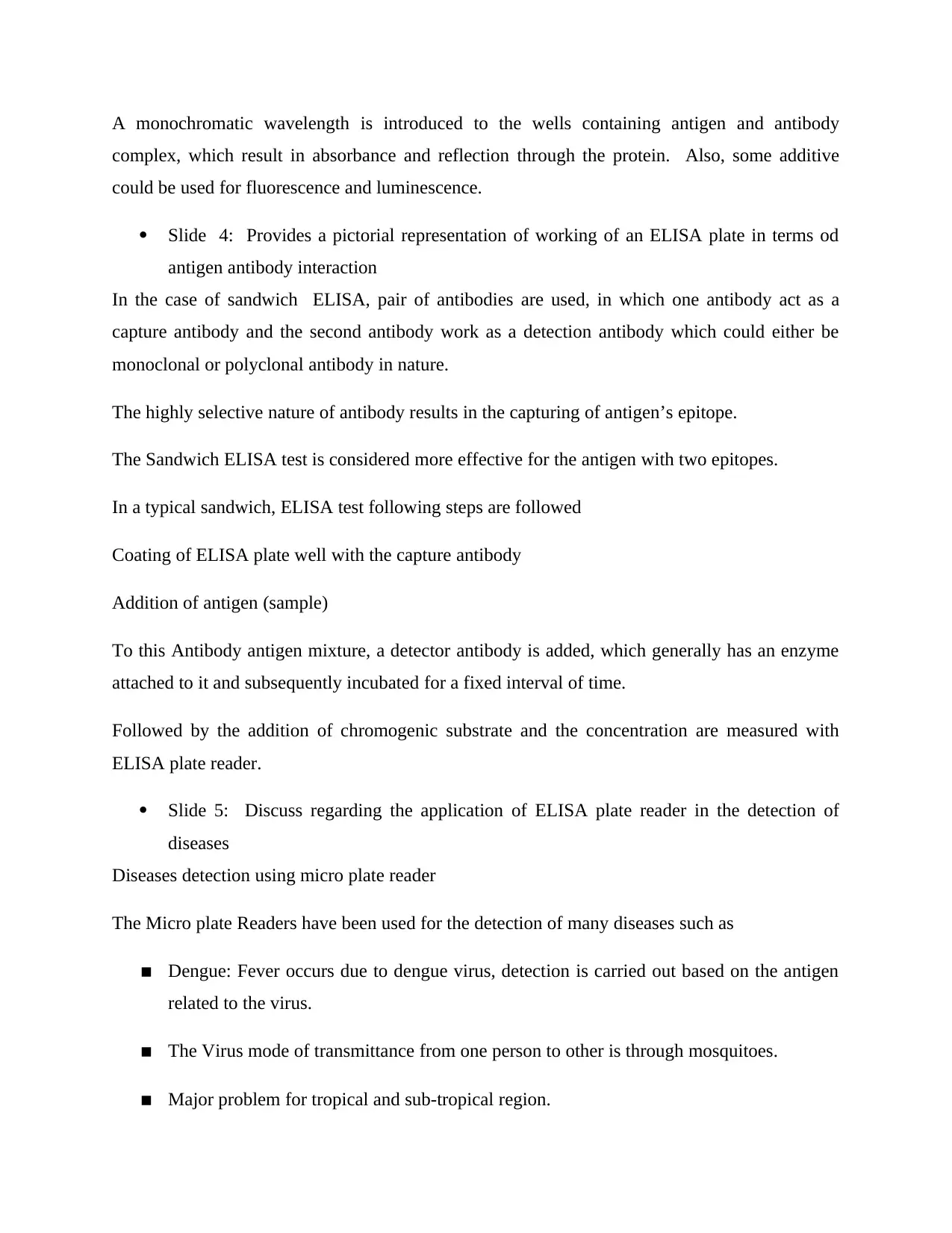
A monochromatic wavelength is introduced to the wells containing antigen and antibody
complex, which result in absorbance and reflection through the protein. Also, some additive
could be used for fluorescence and luminescence.
Slide 4: Provides a pictorial representation of working of an ELISA plate in terms od
antigen antibody interaction
In the case of sandwich ELISA, pair of antibodies are used, in which one antibody act as a
capture antibody and the second antibody work as a detection antibody which could either be
monoclonal or polyclonal antibody in nature.
The highly selective nature of antibody results in the capturing of antigen’s epitope.
The Sandwich ELISA test is considered more effective for the antigen with two epitopes.
In a typical sandwich, ELISA test following steps are followed
Coating of ELISA plate well with the capture antibody
Addition of antigen (sample)
To this Antibody antigen mixture, a detector antibody is added, which generally has an enzyme
attached to it and subsequently incubated for a fixed interval of time.
Followed by the addition of chromogenic substrate and the concentration are measured with
ELISA plate reader.
Slide 5: Discuss regarding the application of ELISA plate reader in the detection of
diseases
Diseases detection using micro plate reader
The Micro plate Readers have been used for the detection of many diseases such as
▪ Dengue: Fever occurs due to dengue virus, detection is carried out based on the antigen
related to the virus.
▪ The Virus mode of transmittance from one person to other is through mosquitoes.
▪ Major problem for tropical and sub-tropical region.
complex, which result in absorbance and reflection through the protein. Also, some additive
could be used for fluorescence and luminescence.
Slide 4: Provides a pictorial representation of working of an ELISA plate in terms od
antigen antibody interaction
In the case of sandwich ELISA, pair of antibodies are used, in which one antibody act as a
capture antibody and the second antibody work as a detection antibody which could either be
monoclonal or polyclonal antibody in nature.
The highly selective nature of antibody results in the capturing of antigen’s epitope.
The Sandwich ELISA test is considered more effective for the antigen with two epitopes.
In a typical sandwich, ELISA test following steps are followed
Coating of ELISA plate well with the capture antibody
Addition of antigen (sample)
To this Antibody antigen mixture, a detector antibody is added, which generally has an enzyme
attached to it and subsequently incubated for a fixed interval of time.
Followed by the addition of chromogenic substrate and the concentration are measured with
ELISA plate reader.
Slide 5: Discuss regarding the application of ELISA plate reader in the detection of
diseases
Diseases detection using micro plate reader
The Micro plate Readers have been used for the detection of many diseases such as
▪ Dengue: Fever occurs due to dengue virus, detection is carried out based on the antigen
related to the virus.
▪ The Virus mode of transmittance from one person to other is through mosquitoes.
▪ Major problem for tropical and sub-tropical region.
⊘ This is a preview!⊘
Do you want full access?
Subscribe today to unlock all pages.

Trusted by 1+ million students worldwide
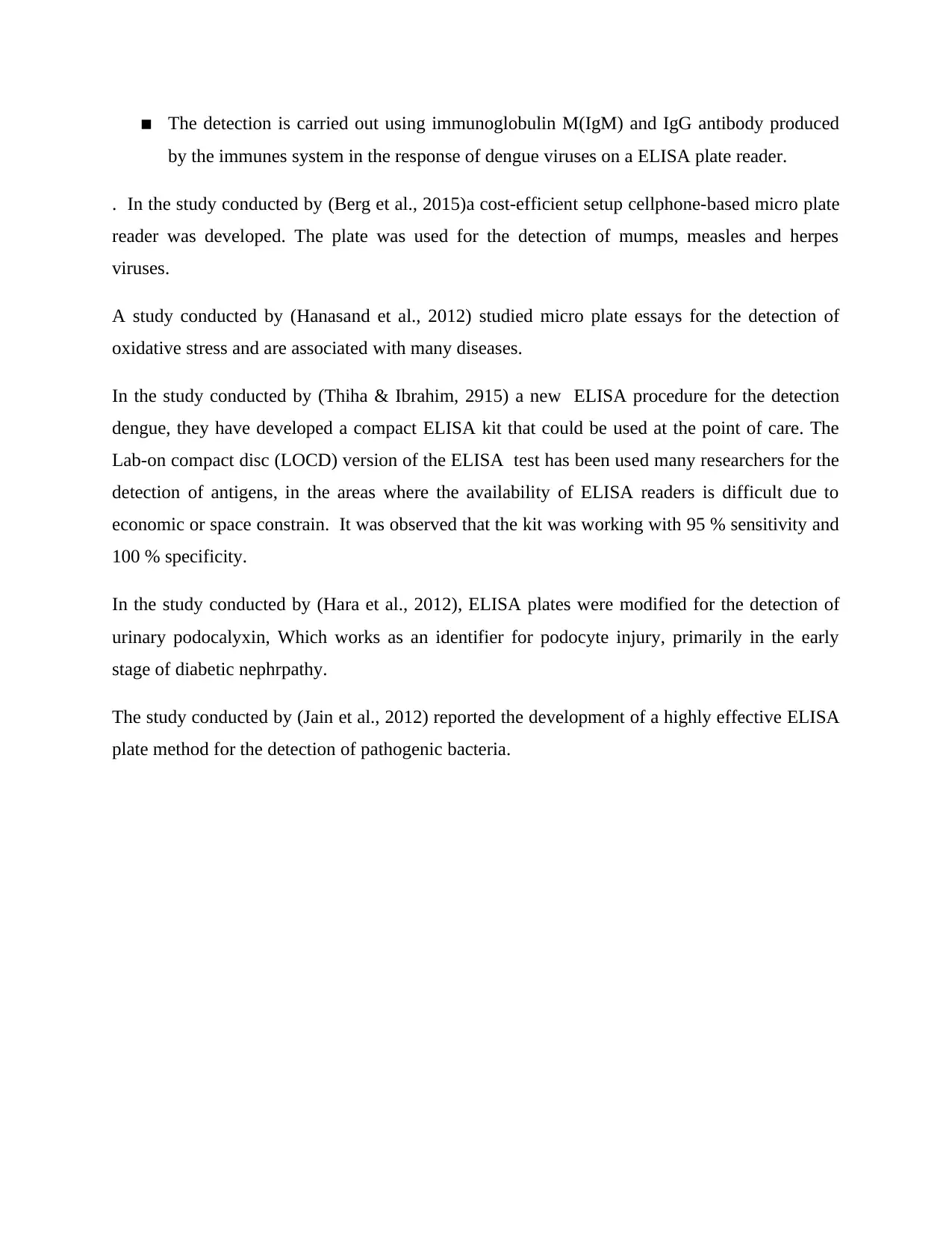
▪ The detection is carried out using immunoglobulin M(IgM) and IgG antibody produced
by the immunes system in the response of dengue viruses on a ELISA plate reader.
. In the study conducted by (Berg et al., 2015)a cost-efficient setup cellphone-based micro plate
reader was developed. The plate was used for the detection of mumps, measles and herpes
viruses.
A study conducted by (Hanasand et al., 2012) studied micro plate essays for the detection of
oxidative stress and are associated with many diseases.
In the study conducted by (Thiha & Ibrahim, 2915) a new ELISA procedure for the detection
dengue, they have developed a compact ELISA kit that could be used at the point of care. The
Lab-on compact disc (LOCD) version of the ELISA test has been used many researchers for the
detection of antigens, in the areas where the availability of ELISA readers is difficult due to
economic or space constrain. It was observed that the kit was working with 95 % sensitivity and
100 % specificity.
In the study conducted by (Hara et al., 2012), ELISA plates were modified for the detection of
urinary podocalyxin, Which works as an identifier for podocyte injury, primarily in the early
stage of diabetic nephrpathy.
The study conducted by (Jain et al., 2012) reported the development of a highly effective ELISA
plate method for the detection of pathogenic bacteria.
by the immunes system in the response of dengue viruses on a ELISA plate reader.
. In the study conducted by (Berg et al., 2015)a cost-efficient setup cellphone-based micro plate
reader was developed. The plate was used for the detection of mumps, measles and herpes
viruses.
A study conducted by (Hanasand et al., 2012) studied micro plate essays for the detection of
oxidative stress and are associated with many diseases.
In the study conducted by (Thiha & Ibrahim, 2915) a new ELISA procedure for the detection
dengue, they have developed a compact ELISA kit that could be used at the point of care. The
Lab-on compact disc (LOCD) version of the ELISA test has been used many researchers for the
detection of antigens, in the areas where the availability of ELISA readers is difficult due to
economic or space constrain. It was observed that the kit was working with 95 % sensitivity and
100 % specificity.
In the study conducted by (Hara et al., 2012), ELISA plates were modified for the detection of
urinary podocalyxin, Which works as an identifier for podocyte injury, primarily in the early
stage of diabetic nephrpathy.
The study conducted by (Jain et al., 2012) reported the development of a highly effective ELISA
plate method for the detection of pathogenic bacteria.
Paraphrase This Document
Need a fresh take? Get an instant paraphrase of this document with our AI Paraphraser
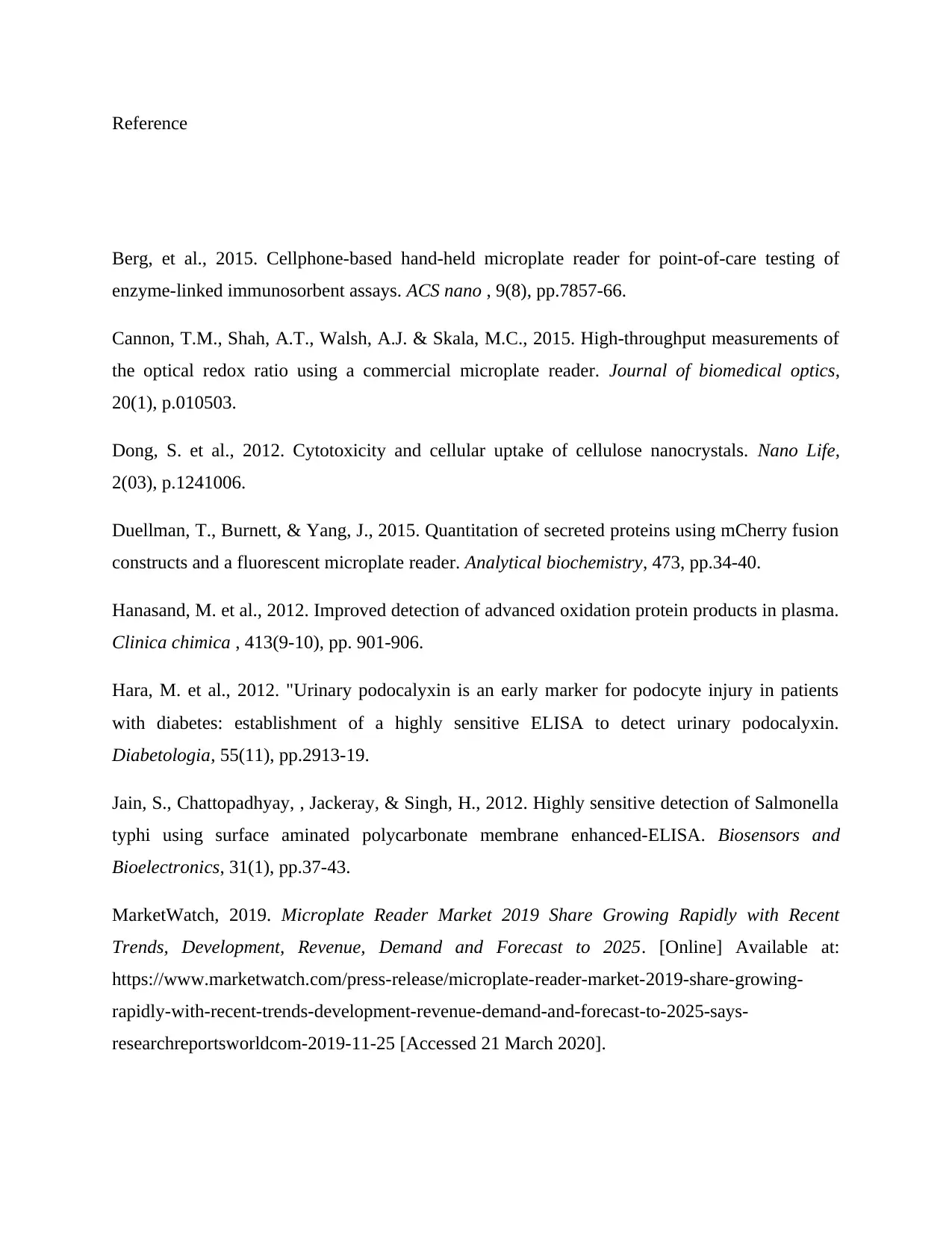
Reference
Berg, et al., 2015. Cellphone-based hand-held microplate reader for point-of-care testing of
enzyme-linked immunosorbent assays. ACS nano , 9(8), pp.7857-66.
Cannon, T.M., Shah, A.T., Walsh, A.J. & Skala, M.C., 2015. High-throughput measurements of
the optical redox ratio using a commercial microplate reader. Journal of biomedical optics,
20(1), p.010503.
Dong, S. et al., 2012. Cytotoxicity and cellular uptake of cellulose nanocrystals. Nano Life,
2(03), p.1241006.
Duellman, T., Burnett, & Yang, J., 2015. Quantitation of secreted proteins using mCherry fusion
constructs and a fluorescent microplate reader. Analytical biochemistry, 473, pp.34-40.
Hanasand, M. et al., 2012. Improved detection of advanced oxidation protein products in plasma.
Clinica chimica , 413(9-10), pp. 901-906.
Hara, M. et al., 2012. "Urinary podocalyxin is an early marker for podocyte injury in patients
with diabetes: establishment of a highly sensitive ELISA to detect urinary podocalyxin.
Diabetologia, 55(11), pp.2913-19.
Jain, S., Chattopadhyay, , Jackeray, & Singh, H., 2012. Highly sensitive detection of Salmonella
typhi using surface aminated polycarbonate membrane enhanced-ELISA. Biosensors and
Bioelectronics, 31(1), pp.37-43.
MarketWatch, 2019. Microplate Reader Market 2019 Share Growing Rapidly with Recent
Trends, Development, Revenue, Demand and Forecast to 2025. [Online] Available at:
https://www.marketwatch.com/press-release/microplate-reader-market-2019-share-growing-
rapidly-with-recent-trends-development-revenue-demand-and-forecast-to-2025-says-
researchreportsworldcom-2019-11-25 [Accessed 21 March 2020].
Berg, et al., 2015. Cellphone-based hand-held microplate reader for point-of-care testing of
enzyme-linked immunosorbent assays. ACS nano , 9(8), pp.7857-66.
Cannon, T.M., Shah, A.T., Walsh, A.J. & Skala, M.C., 2015. High-throughput measurements of
the optical redox ratio using a commercial microplate reader. Journal of biomedical optics,
20(1), p.010503.
Dong, S. et al., 2012. Cytotoxicity and cellular uptake of cellulose nanocrystals. Nano Life,
2(03), p.1241006.
Duellman, T., Burnett, & Yang, J., 2015. Quantitation of secreted proteins using mCherry fusion
constructs and a fluorescent microplate reader. Analytical biochemistry, 473, pp.34-40.
Hanasand, M. et al., 2012. Improved detection of advanced oxidation protein products in plasma.
Clinica chimica , 413(9-10), pp. 901-906.
Hara, M. et al., 2012. "Urinary podocalyxin is an early marker for podocyte injury in patients
with diabetes: establishment of a highly sensitive ELISA to detect urinary podocalyxin.
Diabetologia, 55(11), pp.2913-19.
Jain, S., Chattopadhyay, , Jackeray, & Singh, H., 2012. Highly sensitive detection of Salmonella
typhi using surface aminated polycarbonate membrane enhanced-ELISA. Biosensors and
Bioelectronics, 31(1), pp.37-43.
MarketWatch, 2019. Microplate Reader Market 2019 Share Growing Rapidly with Recent
Trends, Development, Revenue, Demand and Forecast to 2025. [Online] Available at:
https://www.marketwatch.com/press-release/microplate-reader-market-2019-share-growing-
rapidly-with-recent-trends-development-revenue-demand-and-forecast-to-2025-says-
researchreportsworldcom-2019-11-25 [Accessed 21 March 2020].

Thiha, A. & Ibrahim, F., 2915. A colorimetric enzyme-linked immunosorbent assay (ELISA)
detection platform for a point-of-care dengue detection system on a lab-on-compact-disc.
Sensors, 15(5), pp.11431-41.
detection platform for a point-of-care dengue detection system on a lab-on-compact-disc.
Sensors, 15(5), pp.11431-41.
⊘ This is a preview!⊘
Do you want full access?
Subscribe today to unlock all pages.

Trusted by 1+ million students worldwide
1 out of 6
Your All-in-One AI-Powered Toolkit for Academic Success.
+13062052269
info@desklib.com
Available 24*7 on WhatsApp / Email
![[object Object]](/_next/static/media/star-bottom.7253800d.svg)
Unlock your academic potential
Copyright © 2020–2025 A2Z Services. All Rights Reserved. Developed and managed by ZUCOL.
